| << Chapter < Page | Chapter >> Page > |
It is important that the instructor point out that, depending on the type of report, some of the questions from Slide # 17 may not be needed in the abstract.
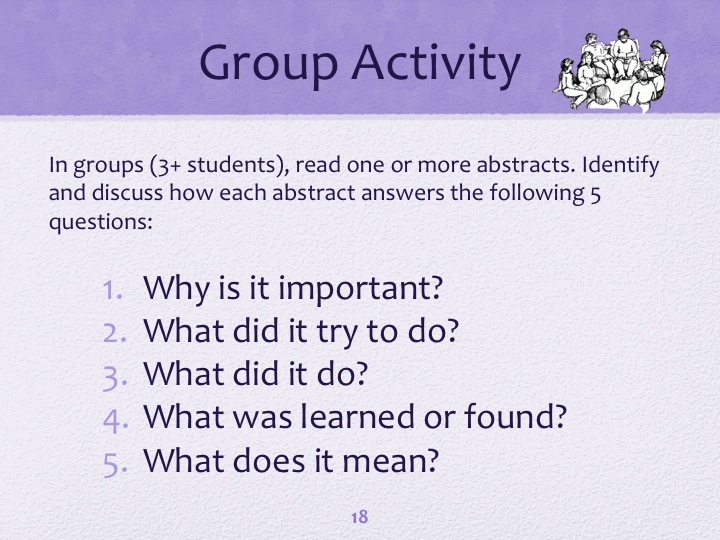
Slides # 19: Titles Attract the Reader; # 20: Effective Titles; # 21 Research Paper Titles.
The instructor should discuss the three slides and emphasize what should and should not be included in a title.
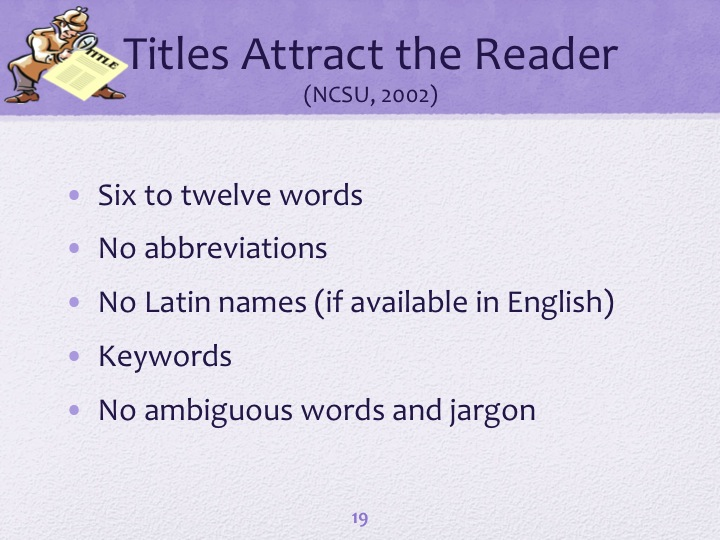
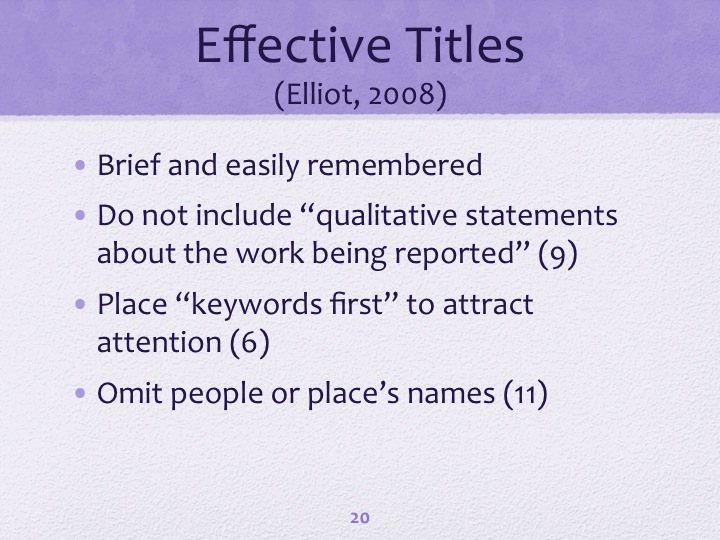
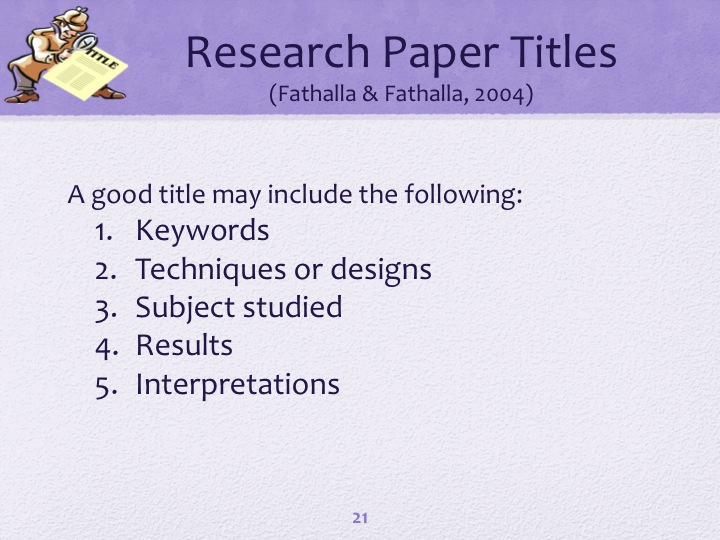
Slide # 22: Group Activity. For this activity, the instructor should provide a list of titles to the students. These titles should vary in accuracy, length, and appropriateness based on the information presented in Slides 19, 20, and 21. Students (in groups) should analyze the titles and discuss their limitations and strengths with their peers. Class dialogue should follow for the students to present and discuss their responses.
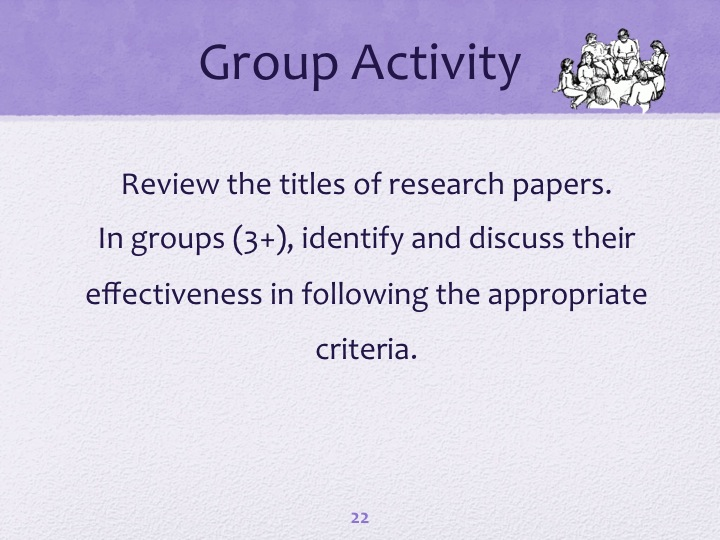
Slide # 23: Summary. Summarize main components of abstracts with the students and emphasize that, due to the numerous types of abstracts, it is important to follow the criteria stipulated by the publication.
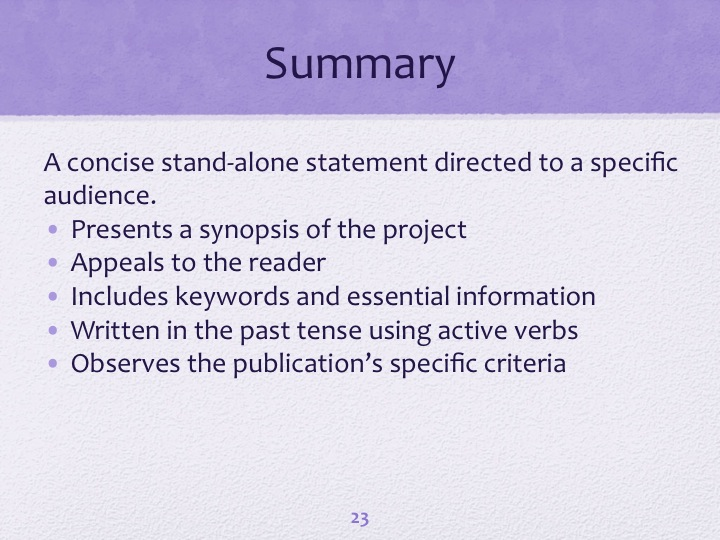
After presenting the module and completing the in-class activities, the instructor should assess students on the knowledge gained from the instruction.
One method would be to quiz individual students with the same practice abstracts and titles that the instructor had provided in the class activities. Another approach would be to present new abstracts and titles for the students to evaluate. Evaluation instruments might be fashioned as short open responses and multiple choice options.
In addition, the links provided in the Materials section (above) of this module also contain exercises that may be adapted for the students.
Albarran, J. (Nov. 2007). Planning, developing, and writing an effective conference abstract. British Journal of Cariac Nursing, 2 (11), 570-572.
Alley, M. (2010). Writing exercises for engineers and scientists. Retrieved June 14, 2012, from http://www.writing.engr.psu.edu/exercises/ANSI/NISO. (1997). Guidelines for abstracts, American National Standards Institute/National Information Standards Organization (pp. i.-14). Bethesda, MD: NISO Press.
Day, R. A.,&Gastel, B. (2011). How to prepare an abstract How to write and publish a scientific paper (7th ed., pp. 53-58). Santa Barbara: Greenwood.
Editage. (2012). Manuscript preparation. Retrieved June 20, 2012, from http://www.editage.com/resources/art11.html
Elliott, C. M. (2008). Writing effective titles [PowerPoint Presentation]. Urbana-Champain: The Board of Trustees of the University of Illionios.
European Respiratory Society (2010). How to write a good abstract. 2012 (May 17). Retrieved from http://erscongress2010.org/1063-abstracts.htm
Fathalla, M. F.,&Fathalla, M. M. F. (2004). A practical guide for health researchers. from http://applications.emro.who.int/dsaf/dsa237.pdf
Koopman, P. (October 1997). How to write an abstract. Retrieved June 3, 2012, from www.ece.cmu.edu/~koopman/essays/abstract.html
Kretchmer, P.,&Blanco, P. (2008). Ten steps to writing an effective abstract. Retrieved 15 June, 2012, from http://www.sfedit.net/abstract.pdf
Leahy, R. (1992). Twenty titles for the writer. College Composition and Communication, 43 (4), 516-519.
McGirr, C. J. (1973). Guidelines for abstracting. Technical Communication, 25 (22), 25.
North Carolina State University at Raleigh. (2002). Be a better author. Retrieved from http://www.ncsu.edu/project/posters/NewSite/documents/betterauthor.pdf
Pritchard, D. R. (1994). The American Heritage Dictionary. In D. R. Pritchard (Ed.), The American Heritage Dictionary (3rd ed.). New York: Laurel.
The University of Adelaide. (2009) Writing an abstract. Writing Centre Learning Guide . Retrieved from http://www.adelaide.edu.au/writingcentre/learning_guides/learningGuide_ writingAnAbstract.pdf

Notification Switch
Would you like to follow the 'Civis project - uprm' conversation and receive update notifications?